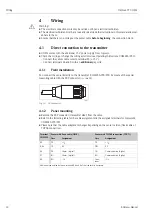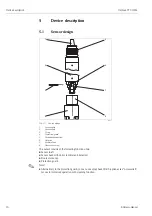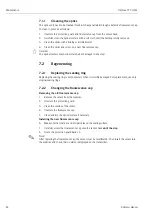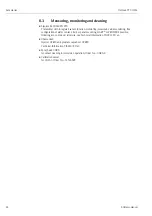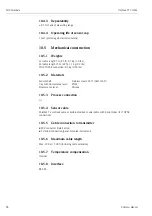
Device description
Oxymax W COS61
18
Hauser
5.3.1
Types of calibration
Types of calibration:
• Air (preferably saturated water vapor, e.g. near the water surface)
– Measured values between 75 and 140 % SAT result in the calibration of the measured value at
air
– Measured smaller than 10 % SAT result in the calibration of the zero point
• Air-saturated water
– Like air calibration
• Reference measured value (entry at transmitter, sensor remains in the medium).
– Measured values between 75 and 140 % SAT result in the calibration of the measured value to
the reference value while maintaining the zero point
– Measured values smaller than 10 % SAT result in the calibration of the measured value to the
reference value while maintaining the measured value at air
If necessary, calibrate COS61 practically:
• In the
air
(water-vapor saturated) type of calibration in order to calibrate the
measured value at
air
.
• In the
air-saturated water
type of calibration, but while using
oxygen-free
water, (see "Sensor
check" section), to calibrate the
zero point
.
5.3.2
Calibration intervals
1.
If you want to calibrate the sensor in the meantime due to a special application and/or a special
type of installation, you can determine the intervals with the following method:
2.
Check the sensor one month after its being put into operation by taking it out of the fluid,
drying it and then measuring the oxygen saturation index at air after 10 minutes.
Decide using the results:
a. If the measured value is not at 100 ±2 %SAT, you have to calibrate the sensor.
b. Otherwise, double the length of time to the next inspection.
3.
Proceed as per Point 1 after two, four and/or eight months. In this way, you can determine
the optimum calibration interval for your sensor.
!
Note!
Be sure to calibrate the sensor at least once a year.
5.3.3
Calibration in air
1.
Remove the sensor from the medium.
2.
Clean the outside of the sensor with a damp cloth. Then dry the sensor membrane e.g. by using
a tissue.
3.
Then wait while the sensor adjusts to the temperature of the ambient air. This takes about 20
minutes. Check that the sensor is not in direct sunlight during this time.
4.
If the measured value display on the transmitter is stable, carry out the calibration in
accordance with the Operating Instructions of the transmitter.
5.
Place the sensor in the medium again.
!
Note!
Make sure you comply with the instructions for calibration in the Operating Instructions of the
transmitter.
5.3.4
Calculation example for the calibration value
As a check, you can calculate the expected calibration value (transmitter display) as shown in the
following example (salinity is 0).











